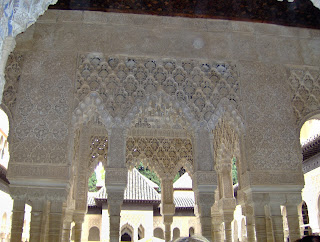The Alhambra is the last and greatest Moorish palace. Granada was held by the Nazarids, an ethnic group of Spanish Muslims, until 1492.
In Tales from the Alhambra, Washington Irving writes: "Such is the Alhambra. A Moslem pile, in the midst of a Christian land; and Oriental palace amidst Gothic edifices of the West; an elegant memento of a brave, intelligent, and graceful people, who conquered, ruled, and passed away."
Water was rare and precious in most of the Islamic world. It was the purest symbol of life to the Moors. The Alhambra is decorated with water--standing still, cascading, drip dropping, and masking secret conversations.




























